
Flash, bam, alakazam
"Orange Colored Sky", originally recorded by Nat King Cole, is one of my favourite jazz classics. If you've never heard it, take a listen. Its lyrics provide an oddly fitting frame for the story I'm about to tell you...
I was walking along, minding my business...
I woke yesterday morning feeling refreshed and optimistic. A cool breeze greeted me, heralding the end of a week-long heatwave. A notification on my phone greeted me too: Tornado WATCH in effect for Waterloo Region. I gave it little thought; there had been extreme weather warnings on and off for the past week. At the moment, the prospect of a breezy bike ride to work was a much more commanding presence.
When out of an orange coloured sky...
At lunch, I enjoyed listening to a jazz quartet at Waterloo Town Square. It was the first day of the weekend-long festival, and everyone was in high spirits. Settling into a plastic patio chair, I ate my lunch and got blissfully lost in the dull rumble of the double bass, the vocalist's smooth timbre, the unexpected path of a guitar solo...
Keeping time with the band, my morning breeze crescendoed into a gale-force wind. Toppling canvas shelters and sending sheet music into disarray, mother nature sought to add her own improvised percussion to the mix. And the band played on.
Flash, bam, alakazam!
Fast-forward to 5:00 PM, when the clouds burst above me on my commute home. Fat drops of rain cooled my back and hissed against the hot pavement. It was the definitive and welcome end to a week of unbearably hot weather.
Back at home now (and having changed into dry clothes), a storm quickly gathered. I watched the rain begin to fall in sheets, and the prospect of sauntering in a summer thunderstorm was too much to resist. In a split-second decision, Melissa and I fled out the front door and up the puddle-strewn street, laughing, running, splashing —
CRACK
A beautiful, big old tree in the yard behind Suddaby School snapped in half before our eyes. Buffeted by the wind and heavy with rain, its limbs could not withstand the pressure of the storm. Its top half hung down, limp, hinged by a few remaining strands of bark.
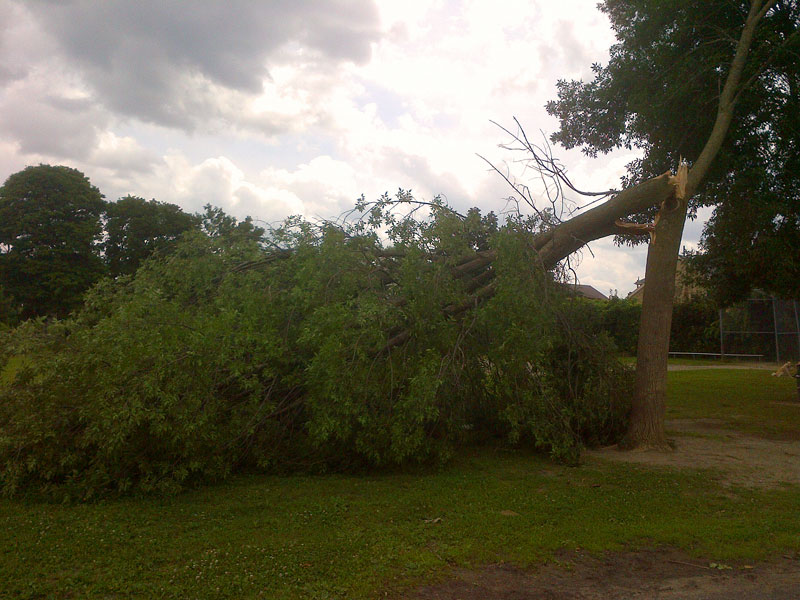
This tree snapped like a twig before our eyes. Photo taken two days after the storm.
We stared in amazement – first at the tree, then at each other. Furtive steps across the schoolyard to take a closer look. Nervous jumps as lightning cracked above us. But we had to keep going. Circling around the south side of the 150-year-old school (avoiding the more heavily treed north flank), we came upon a scene of carnage.
Unlike the storm's first victim – a clean execution, no mess – Suddaby School's majestic front yard was littered with the mangled bodies of saplings, mixed among limbs and leaves of larger trees. The two tall, thin evergreens that frame the school's entrance were bending dangerously in the wind.
Melissa and I scampered up the stone steps to seek shelter in the main entranceway. We surveyed the destruction with awe and paid our respects to the dead. The evergreens creaked – our cue to leave.
We crossed the road, welcoming the relative safety and open space along Otto Street, running past the Centre in the Square. The rain had intensified, and the drops felt like hail as they pelted through our wet t-shirts. The wind, too, had strengthened enough to knock me sideways like an unexpected bodycheck.
Approaching Queen Street, we saw that the traffic lights were down – both figuratively and literally. A grand old tree (albeit with a rotting trunk) had snapped at the base and took down the adjacent light pole when it collapsed. Like a paperclip in a fidgeter's hands, the traffic light pole lay irreparably twisted across the sidewalk.
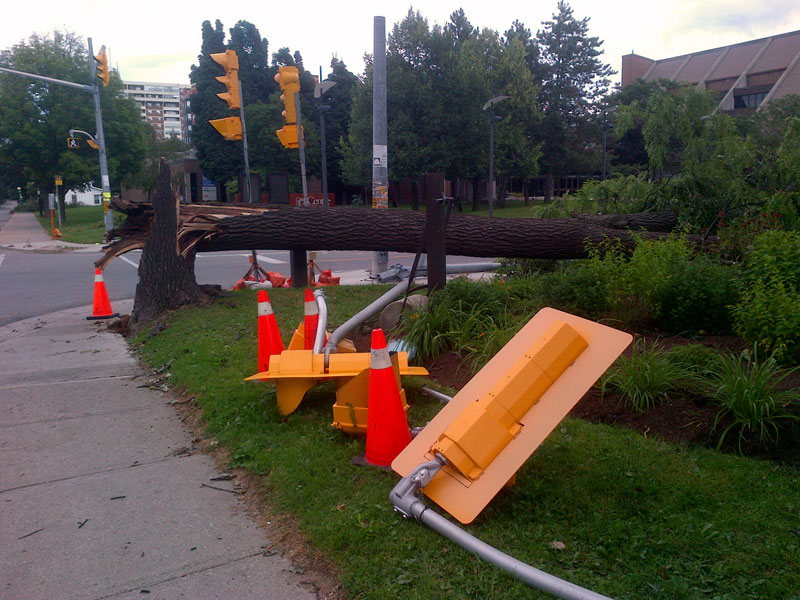
A stump of the pole remains standing, but the mangled metal tubing has been cut into neat pieces by City crews. Photo taken two days after the storm.
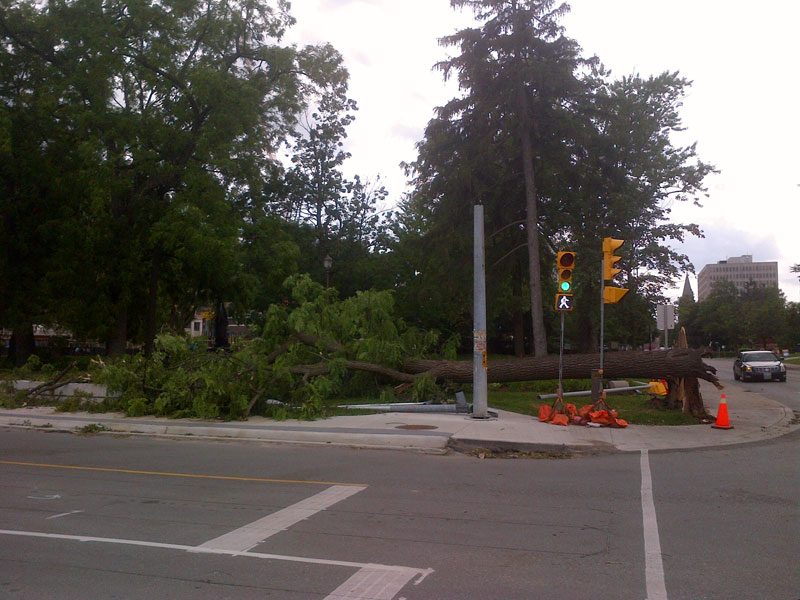
Temporary traffic lights stand in for the real thing until City crews remove the tree and install a new pole. Photo taken two days after the storm.
Wonderful you came by...
At this point, we met two teenage girls who had been walking along Queen Street. The four of us quickly multiplied to eight, with the introduction of a father and his son, another man and his golden retriever. We got the sense that there was more we could do than stand, gaping, at the destruction. Together, we got to work on removing a tree that had fallen across Queen Street, kiddie-corner to the mangled traffic light. The man and his dog directed confused drivers away from the blocked street, while the rest of us lifted branches and cleared debris. Front yards filled up with branches, the notion of private property having been lost to the common good.
At the next block, there was another fallen tree blocking the road. And one block further, yet another. As we made our way along Queen Street to repeat the anarchic ballet that we had started, our numbers grew. Eight, then sixteen, then thirty-two... By the time we had successfully cleared a lane for traffic, there were dozens of neighbours out on the street.
Eventually, someone brought a saw. Someone else had an axe. Branches that were too big to move by brawn alone were chopped and sliced in a flurry of machismo by men self-consciously approaching middle age.
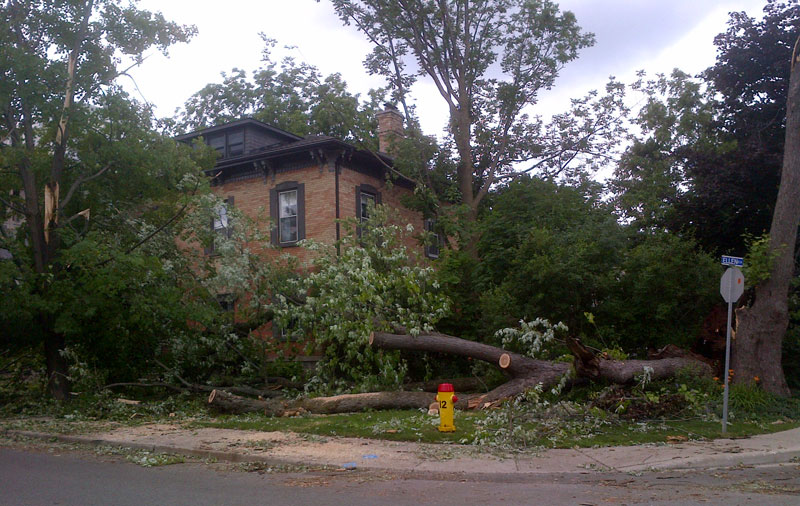
Front lawns became the de facto holding areas for debris. Photo taken two days after the storm.
One look and I yelled, "Timber!"
Our work on Queen Street done, Melissa and I decided to venture back toward home, nervously anticipating the fate of our little house, not to mention the 100-year-old tree that towers above it.
The orderly street grid of Central Frederick had become a labyrinth. Downed trees and power lines hampered access for cars and pedestrians alike. Lancaster Street, Chapel Street, Brubacher Street, Samuel Street – they were all subject to the ravages of the storm.
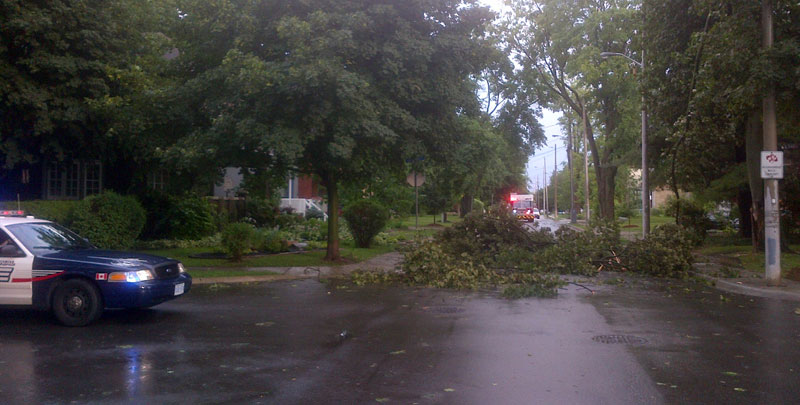
A Police cruiser and fire truck tend to a smouldering tree on Samuel Street. A downed power line had set the wood on fire in the middle of the street. Photo taken the day of the storm.
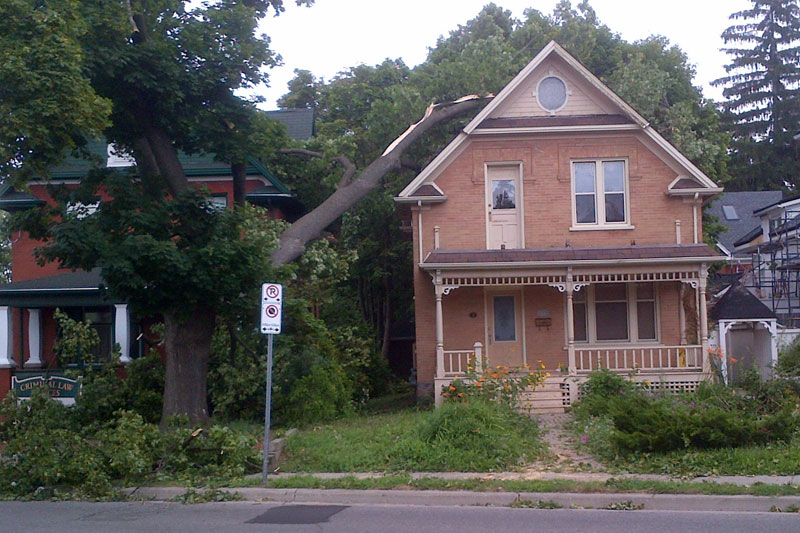
A tree limb thicker than my waist landed with a thud on a Lancaster Street home, cracking the roof and ceiling. Photo taken two days after the storm.
Our house, thankfully, was safe and sound. Our regal backyard tree, however, had lost a large portion of its crown. One limb flattened our neighbour's fence to the rear. Another large branch fell to the side, damaging the tin shed next door.
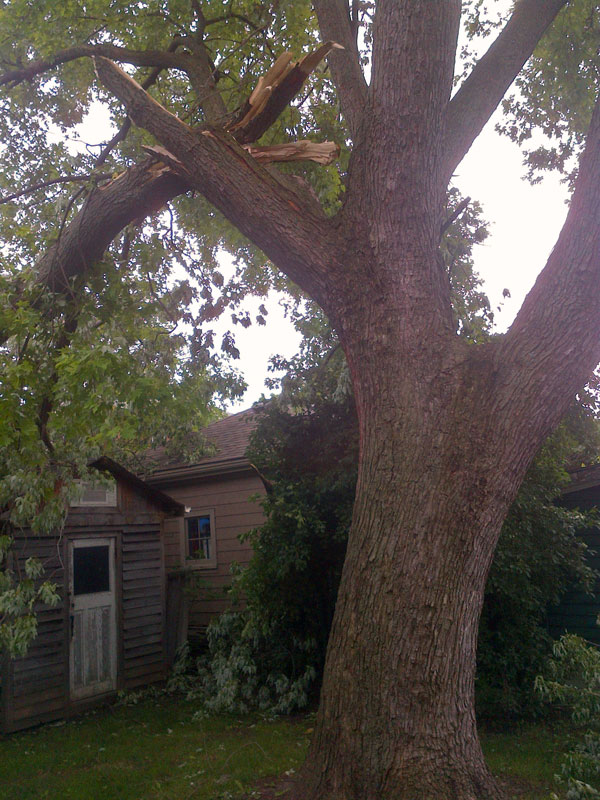
Fortunately, the limbs that broke off our tree all fell in the opposite direction of our house. Photo taken two days after the storm.
Over the next few hours, I heard reports of similar occurrences in Victoria Park, the Mary-Allen neighbourhood in Waterloo, Bloomingdale, and even as far away as Hamilton and Toronto. The storm lasted a mere half-hour, but we'll be dealing with the aftermath for weeks.
Postscript
I referred to the spontaneous community that came together on Queen Street as an "anarchic ballet". Strangers coming together to help one another out is always a good thing, but I don't want to confound our unity against the storm with a broader, more general unity. As beautiful as it was to work ad-hoc with so many people pushing, pulling, sawing and hacking away to clear the road, once the job was done we all disbanded. Our cooperation was largely utilitarian.
Without a regular stream of crises to force the community together, it will quickly revert to a collection of individuals, bound together only by geography. The storm also created tension among neighbours. Many trees fell on other peoples' property, ruining gardens, damaging sheds, and tearing up lawns. Long after the streets are cleared and hydro lines are repaired, animosity will continue to bubble under the surface. Irritation that was originally directed at the storm will find a new target – first the tree itself, then the person on whose property the tree stands (or once stood, as may be the case). Filing insurance claims and coordinating fence repair are not the best foundations for a relationship.
All this to say that with the storm over and clean-up looming ahead, be gracious and humble with one another. And never forget that we hold collective responsibility for the increase in extreme weather.
For more photos of the aftermath, check out this Facebook photo album from Tina Shields, a resident in my neighbourhood.
Sam Nabi